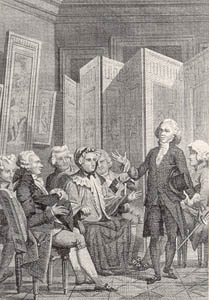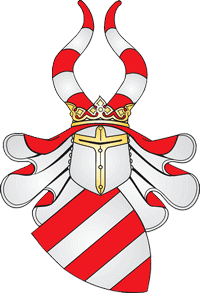|
Johanna Von Puttkamer
Johanna Friederike Charlotte Dorothea Eleonore, Princess of Bismarck, Duchess of Lauenburg (née von Puttkamer; 11 April 1824 – 27 November 1894) was a Prussian noblewoman and the wife of the 1st Chancellor of Germany, Otto von Bismarck. Early life She was born at Viartlum manor near Rummelsburg in the Prussian Province of Pomerania (present-day Wiatrołom, Poland), the daughter of Heinrich von Puttkamer (1789–1871) and his wife Luitgarde Agnes von Glasenapp (1799–1863). Her ancestors of the Puttkamer noble family, first mentioned in the 13th century, belonged to the ''Uradel'' dynasties of Farther Pomerania and were known for their devoted pietism.Encyclopædia Britannica, 2009 Johanna grew up in neighbouring Reinfeld estate (Barnowiec), which her father acquired shortly after her birth. Life Johanna met Otto von Bismarck, then owner of Kniephof estate (Konarzewo), in 1844. The Prussian Junker had associated with Pomeranian pietist circles around Adolf von Thadden-Tr ... [...More Info...] [...Related Items...] OR: [Wikipedia] [Google] [Baidu] |
Wiatrołom
Wiatrołom (german: Viartlum, csb, Wiatrołóm) is a village in Gmina Miastko, Bytów County, Pomeranian Voivodeship, in northern Poland. It lies approximately west of Bytów and south-west of Gdańsk (capital city of the Pomeranian Voivodeship). From 1975 to 1998 the village was in Słupsk Voivodeship. It has a population of 63. Notable people * Johanna von Puttkammer (1824–1894) a Prussian noblewoman and the wife of the 1st Chancellor of Germany, Otto von Bismarck. References *Map of the Gmina Miastko Villages in Bytów County {{Bytów-geo-stub ... [...More Info...] [...Related Items...] OR: [Wikipedia] [Google] [Baidu] |
Salon (gathering)
A salon is a gathering of people held by an inspiring host. During the gathering they amuse one another and increase their knowledge through conversation. These gatherings often consciously followed Horace's definition of the aims of poetry, "either to please or to educate" (Latin: ''aut delectare aut prodesse''). Salons in the tradition of the French literary and philosophical movements of the 17th and 18th centuries were carried on until as recently as the 1920s in urban settings. Historical background The salon was an Italian invention of the 16th century, which flourished in France throughout the 17th and 18th centuries. The salon continued to flourish in Italy throughout the 19th century. In 16th-century Italy, some brilliant circles formed in the smaller courts which resembled salons, often galvanized by the presence of a beautiful and educated patroness such as Berta Zuckerkandl, Isabella d'Este or Elisabetta Gonzaga. Salons were an important place for the exchange of i ... [...More Info...] [...Related Items...] OR: [Wikipedia] [Google] [Baidu] |
Nikolay Alexeyevich Orlov
Nikolay Alekseyevich Orlov (russian: Николай Алексеевич Орлов; April 27, 1827 — March 17, 1885) was a Russian nobleman, soldier, social reformer and diplomat. He started his career as an officer in the Russian army, and later served variously as the Russian ambassador to Belgium, Great Britain, France, the Austro-Hungarian Empire, and Germany. He was primarily responsible for the end of corporal punishment under Russian law. Orlov was born in St. Petersburg to Prince, then Count, Alexei Grigoryevich Orlov and his wife Olga Alexandrovna (nee Zherebtsova). He studied law, and in 1843, he became a page at the Russian Imperial Court. In 1845, he was assigned to the Life Guard Horse Regiment. In 1846, he was attached to the staff of Grand Duke Konstantin Nikolayevich, the Tzar's son. In 1849, he distinguished himself in the suppression of the 1848 Hungarian uprising, and was promoted to captain. From 1851 to 1854 he served on the General Staff and in t ... [...More Info...] [...Related Items...] OR: [Wikipedia] [Google] [Baidu] |
Russian Empire
The Russian Empire was an empire and the final period of the Russian monarchy from 1721 to 1917, ruling across large parts of Eurasia. It succeeded the Tsardom of Russia following the Treaty of Nystad, which ended the Great Northern War. The rise of the Russian Empire coincided with the decline of neighbouring rival powers: the Swedish Empire, the Polish–Lithuanian Commonwealth, Qajar Iran, the Ottoman Empire, and Qing China. It also held colonies in North America between 1799 and 1867. Covering an area of approximately , it remains the third-largest empire in history, surpassed only by the British Empire and the Mongol Empire; it ruled over a population of 125.6 million people per the 1897 Russian census, which was the only census carried out during the entire imperial period. Owing to its geographic extent across three continents at its peak, it featured great ethnic, linguistic, religious, and economic diversity. From the 10th–17th centuries, the land ... [...More Info...] [...Related Items...] OR: [Wikipedia] [Google] [Baidu] |
Orlov Family
Orlov (russian: Орлóв) is the name of a Russian noble family which produced several distinguished statesmen, scientists, diplomats, and soldiers. The family first gained distinction in the 18th century through the achievements of five Orlov brothers, of whom the second eldest was Catherine the Great's paramour, and two younger brothers were notable military commanders. Orlov brothers Grigory Grigoryevich Orlov Count Grigory Grigoryevich Orlov (1734–1783), who created for his family such an illustrious Russian history, was the son of Gregory Orlov, governor of Great Novgorod. He was educated in the corps of cadets at St Petersburg, began his military career in the Seven Years' War, and was wounded at Zorndorf. While serving in the capital as an artillery officer he caught the fancy of Grand Duchess Catherine Alekseyevna, and was the leader of the conspiracy which resulted in the dethronement and death of her husband Peter III (1762). After the event, Catherine ... [...More Info...] [...Related Items...] OR: [Wikipedia] [Google] [Baidu] |
Arnim Family
The House of Arnim is the name of an ancient German noble family, originally from Altmark, part of the mediaeval March of Brandenburg. Members of the family occupied many important positions within Holy Roman Empire, Saxony, Prussia, German Empire and the German Reich. History They are one of the oldest extant Prussian noble families, being first attested to in 1204. On 2 October 1786, one branch of the family was raised to the title of Count in Prussia by King Frederick William II, while a second branch was raised to the same title in 1870 by King William I of Prussia. The Count von Arnim-Boitzenburg was one of the hereditary members of the Prussian House of Lords from 1852-1918, when it was dissolved. Numerous branches of the family still exist today. Perhaps the most famous member of the family was the novelist, Countess Elizabeth von Arnim-Schlagenthin. Properties File:Schloss_Boitzenburg_vorne_links.jpg, Castle Boitzenburg File:1024_Fürst_Pückler_Schloss_Bad_Musk ... [...More Info...] [...Related Items...] OR: [Wikipedia] [Google] [Baidu] |
Hoyos Family
The House of Hoyos is a Spanish and Austrian noble family. It derives its name from El Hoyo de Pinares in Ávila, Castile and León, and can be traced to the 9th century. Juan de Hoyos and his family accompanied the later Ferdinand I, Holy Roman Emperor, to Lower Austria in 1525, founding the Austrian branch of the family. This branch rose to prominence in Austria and in Hungary as Hungarian magnates over the centuries. The older line of the family was elevated to imperial counts in 1628, and became extinct in 1718. A younger line was elevated to imperial counts in 1674. Notable members * Ernst Karl von Hoyos-Sprinzenstein (1830–1903), Austrian landowner and politician *Alexander, Count of Hoyos Ludwig Alexander Georg Graf von Hoyos, Freiherr zu Stichsenstein (13 May 1876 – 20 October 1937) was an Austro-Hungarian diplomat who played a major role during the July Crisis while serving as chef de cabinet of the Foreign Minister at the ou ... (1876-1937), Austro-Hungarian ... [...More Info...] [...Related Items...] OR: [Wikipedia] [Google] [Baidu] |
House Of Hatzfeld
The House of Hatzfeld, also spelled Hatzfeldt, is the name of an ancient and influential German noble family, whose members played important roles in the history of the Holy Roman Empire, Prussia and Austria. History They belonged to high nobility originally from Hesse. The family is first mentioned in 1138 and has its ancestral seat in Hatzfeld. In 1418 the family inherited Wildenburg Castle near Friesenhagen, a Lordship with Imperial immediacy, from the Lords of Wildenburg. Titles Melchior von Hatzfeld (1593–1658), Imperial field marshal in the Thirty Years' War, became the first Count in 1635. He was enfeoffed with Trachenberg Castle in Silesia in 1641, and Gleichen Castle with the town of Wandersleben in Thuringia in 1651. Franz Phillip Adrian became the first Prussian Fürst (''Prince of Hatzfeld-Gleichen-Trachenberg'') in 1741 (the branch extinguished in 1794). The ''Hatzfeldt-Werther-Schönstein'' branch inherited Trachenberg and became Prussian ''Princes of Hatzfel ... [...More Info...] [...Related Items...] OR: [Wikipedia] [Google] [Baidu] |
Imperial County Of Rantzau
The Imperial County of Rantzau (german: Reichsgrafschaft Rantzau) was an immediate state of the Holy Roman Empire. Its territory is more or less congruent with the present ''Amt'' Rantzau. In 1649, Frederick III, Duke of Holstein-Gottorp, sold his part of the Lordship of Pinneberg, which had formerly belonged to the County of Schauenburg, to Count Christian zu Rantzau (1614–1663), royal Danish governor of Holstein. In 1650 or 1651, Rantzau became an immediate county and state of the Holy Roman Empire. In 1726, it was annexed by the Danish rulers, after Wilhelm Adolf, Count of Rantzau (1688-1734), had murdered his brothers and was imprisoned. Wilhelm Adolf died in 1734 and Rantzau was inherited by the Duchy of Holstein The Duchy of Holstein (german: Herzogtum Holstein, da, Hertugdømmet Holsten) was the northernmost state of the Holy Roman Empire, located in the present German state of Schleswig-Holstein. It originated when King Christian I of Denmark had hi ..., which ... [...More Info...] [...Related Items...] OR: [Wikipedia] [Google] [Baidu] |
Kołczygłowy
Kołczygłowy (; formerly german: Alt Kolziglow) is a village in Bytów County, Pomeranian Voivodeship, in northwestern Poland. It is the seat of the gmina (administrative district) called Gmina Kołczygłowy. It lies approximately north-west of Bytów and west of the regional capital Gdańsk. The rural church was the place of the marriage of Otto von Bismarck and Johanna von Puttkamer on 28 July 1847. The village has a population of 1,188. Notable people * Czesław Lang (born 1955 in Kołczygłowy) a Polish former road racing cyclist. See also History of Pomerania The history of Pomerania starts shortly before 1000 AD with ongoing conquests by newly arrived Polans rulers. Before that, the area was recorded nearly 2000 years ago as Germania, and in modern-day times Pomerania is split between Germany and Po ... References Villages in Bytów County {{Bytów-geo-stub ... [...More Info...] [...Related Items...] OR: [Wikipedia] [Google] [Baidu] |




.png)


